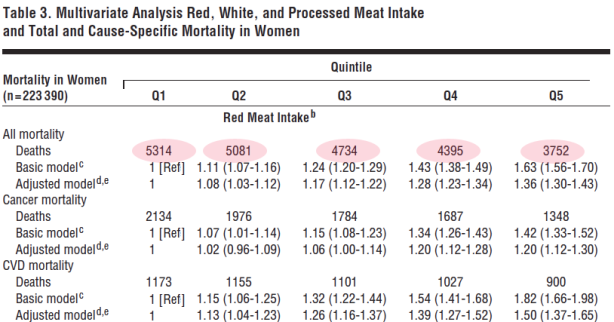As the nutrition world implodes, there are a lot of accusations about ulterior motives and personal gain. (A little odd, that in this period of unbelievable greed — CEO’s ripping off public companies for hundreds of millions of dollars, congress trying to give tax breaks to billionaires — book authors are upbraided for trying to make money). So let me declare that I am not embarrassed to be an author for the money — although the profits from my book do go to research, it is my own research and the research of my colleagues. So beyond general excellence (not yet reviewed by David Katz), I think “World Turned Upside Down” does give you some scientific information about red meat and cancer that you can’t get from the WHO report on the subject.
The WHO report has not yet released the evidence to support their claim that red meat will give you cancer but it is worth going back to one of the previous attacks. Chapters 18 and 19 discussed a paper by Sinha et al, entitled “Meat Intake and Mortality.” The Abstract says “Conclusion: Red and processed meat intakes were associated with modest increases in total mortality, cancer mortality, and cardiovascular disease mortality,” I had previously written a blogpost about the study indicating how weak the association was. In that post, I had used the data on men but when I incorporated the information into the book, I went back to Sinha’s paper and analyzed the original data. For some reason, I also checked the data on women. That turned out to be pretty surprising:

I described on Page 286: “The population was again broken up into five groups or quintiles. The lower numbered quintiles are for the lowest consumption of red meat. Looking at all cause mortality, there were 5,314 deaths [in lowest quintile] and when you go up to quintile 05, highest red meat consumption, there are 3,752 deaths. What? The more red meat, the lower the death rate? Isn’t that the opposite of the conclusion of the paper? And the next line has [calculated] relative risk which now goes the other way: higher risk with higher meat consumption. What’s going on? As near as one can guess, “correcting” for the confounders changed the direction….” They do not show most of the data or calculations but I take this to be equivalent to a multivariate analysis, that is, red meat + other things gives you risk. If they had broken up the population by quintiles of smoking, you would see that that was the real contributor. That’s how I interpreted it but, in any case, their conclusion is about meat and it is opposite to what the data say.
So how much do you gain from eating red meat? “A useful way to look at this data is from the standpoint of conditional probability. We ask: what is the probability of dying in this experiment if you are a big meat‑eater? The answer is simply the number of people who both died during the experiment and were big meat‑eaters …. = 0.0839 or about 8%. If you are not a big meat‑eater, your risk is …. = 0.109 or about 11%.” Absolute gain is only 3 %. But that’s good enough for me.
Me, at Jubilat, the Polish butcher in the neighborhood: “The Boczak Wedzony (smoked bacon). I’ll take the whole piece.”

Boczak Wedzony from Jubilat Provisions.
Rashmi Sinha is a Senior Investigator and Deputy Branch Chief and Senior at the NIH. She is a member of the WHO panel, the one who says red meat will give you cancer (although they don’t say “if you have the right confounders.”)
So, buy my book: Amazon, Alibris, or
Direct: Personalized, autographed copy $ 20.00 free shipping USA only. Use coupon code: SEPT16
The table on p.16 of Sinhala et al 2009 is very interesting too.
Red meat in upper quintile is significantly associated with lower cancer death rate in men (0.68, CI 0.65-0.72 in unadjusted model, 0.84, CI 0.80-0.88 in adjusted model, p <.0001).
Well what did you expect from a probable carcinogen.
Thanks. I will check on it. The whole things is without significant results.
As I read the study, the quintiles are for the whole population, men and women together. So while Q1 and Q5 have the same number of people (by definition), they don’t have the same number of women. Thus the raw mortality numbers go the opposite direction of the risk ratios.
No. I believe the total number of women was different than men. In any case, the dependence on intake should be the same, no? Of course, the real problem is that even if you go with their numbers, the error in food records is such that you would have to have much better than the typical 1.5 hazard ratio.
It would certainly make things clearer if the total n=x in each quintile were given at the top of each table. It took me a bit of digging in the EPIC meat and mortality data to learn that the upper category (out of 6, but it would be wrong to call it a sextile) actually represented the top <1% of meat consumption in the population, because results were grouped by arbitrary cut-offs not even divisions.
http://profgrant.com/2015/10/28/red-meat-processed-meat-and-cancer-how-strong-is-the-evidence/
From that I gathered that a lot of thought goes into making these things as convincing as possible, rather than as informative as possible.
If you think about it, quantiles are not necessary at all since the independent variable is more or less continuous, but the whole epidemiological mission has been, in my view, a nearly complete disaster.
I’ve already got your excellent book.
That bacon looks good.
Thanks. The bacon is very good.
I have a newspaper article in my files dated Thursday, July 3, 2008. Article headline: At age 106, Bigfork angler enjoys day of lake fishing Article ends: “As she fished from the dock, slowly retrieving a lure and hoping for a strike, she passed along her secret for a long life. “I eat bacon every morning,” she said. “Crisp bacon.”
Makes sense to me.
Just wondering if US bacon/ sausages sold in stores have sodium Nitrate / Nitrite in them as preserving agents? In UK they do… Both chems are inked to inflammation/Cancer
Whew, glad to hear this!
If you look at the graph in this article, you will see that lung cancer and colon cancer rates both went down sharply after peaking in 1985 to 1990. it is obvious that WHO was right about one of the things they claim causes cancer–a dramatic decline in smoking seems to fit the timeline. “Global health experts listed processed meat as a cancer-causing substance—the highest of five possible rankings, shared with alcohol, asbestos, arsenic and cigarettes.” https://reason.com/archives/2015/10/27/putting-the-who-cancer-report-in-perspec/print
This total lack of perspective is the hallmark of the medical nutrition world.
Have you ever seen a nutrition-and-cancer study that controlled for exposure to environmental and workplace carcinogen exposure?
In diet heart studies, smoking is controlled for because it’s an oral pleasure, but other sources of smoke particles and atherogenic chemicals are not.
Trends in pollution over time closely match CVD trends.
These people live in their own little bubble.
There you go again, puddleg, dragging in reasonableness and common sense. AS my colleague, Dr. Eugene Fine pointed out: if you look at the map in the China Study that had the highest meat intake and (therefore?) highest cancer, they also had the highest industrial pollution.
Great! Glad to see a new post. P
[…] Source: Red meat and cancer […]
[…] Inlägg på Richard Feinmans blog. Han har tittat på siffror som har redovisats i rött kött-argumentationen. Det finns ett litet samband mellan mäns konsumtion av rött kött och chark – död, men siffrorna är motsatta för kvinnor. Intressant. […]
Just finished the book. Thank you ever so much. It is a feast for a functioning brain. I like subtlety, and especially a book which sends me frequently to the dictionary. I took notes on the thermodynamics chapter, later put them into a Word document, and I get it: metabolic advantage for weight loss needs little more than an endergonic process taking place over time. Loved the food section near the back (and love to prepare food). I’ve never had a serious weight problem, but all my life I’ve been interested in the relationship between food and disease, ever since my father passed away of a heart attack at age 32 in 1952. For a long time I believed the experts, but about ten years ago I stopped eating all industrial food, and over eight months or so, lost 25 pounds (and haven’t gotten sick since). Nearly two years ago I stopped eating grains, and lost what little belly fat I had (I eat more fruits and vegetables now, but lots of seafood, red meat, and organs). It is a beautiful thing that Katz and his ilk are back on their heels. I think we’ve reached the tipping point. I did send a scathing comment to the Guidelines committee during the open comment period. I suspect they got many such. Thanks again.
Thanks. Congratulations on your success. I agree that we have reached some kind of tipping point but as in the new post, it may be a tough grind.
Hi Doc…Have you encountered this recent research paper? The main Author appears to be bona fide academic, but as the research was carried out predominantly on mice I don’t know what to make of its relevance http://www.pnas.org/lens/pnas/112/2/542#content/contributor_reference_12
For some reason, this blog post came up when I was searching for “extreme quintile hazard ratio”. It wasn’t what I was looking for, but I found it very interesting nevertheless.
Setting aside whether or not we’re in agreement about the significance of meat consumption in disease, it struck me that there is a much simpler explanation why the quintile numbers don’t align with the calculated HR numbers or the authors’ conclusions. My guess is that this is simply a typographical error, and that the ordering of the quintiles is reversed.
Skimming the other data in the table reveals other obvious mistakes: a little lower on the same page, the authors switch to “white meat quintiles”, yet the table heading on the next page still says “red meat quintiles” — clearly erroneously. So at a minimum the authors/editors have been careless in their proof-reading.
What other explanation is there for these peculiar data? That red meat consumption is strongly positively correlated with mortality in men, yet the exact same phenomenon is completely reversed in women?